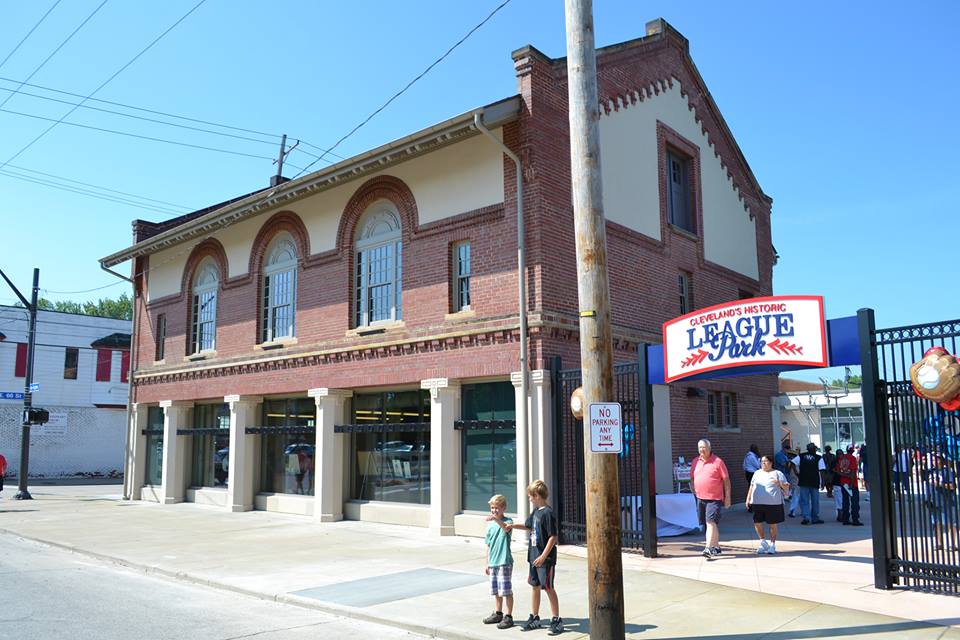The Cleveland Indians held out for many years, but eventually League Park’s run as the team’s full-time home came to an end. More than a decade after it was built, the Indians made Cleveland Municipal Stadium their home for good after the 1946 season, ending a long history of baseball at the corner of East 66th Street and Lexington Avenue. While much of League Park met its demise in the years after the Indians’ departure, some structures from the historic ballpark remain in place today, serving as a testament to the history of baseball in Cleveland.
Baseball was first played at the site of League Park in 1891, when a wooden ballpark opened for the Cleveland Spiders. The original League Park to occupy the site lasted through the 1909 season, when it made way for a new structure that was more reflective of its time. Just as many cities either already had, or were about to do, Cleveland opened a concrete and steel ballpark for its American League franchise—then known as the Cleveland Naps—for the 1910 season.
The Naps did not become the Indians until 1915, and League Park eventually took on a new name. Beginning in 1921, League Park officially became Dunn Field—in recognition of Indians owner Jim Dunn—and kept that name for several years after Dunn’s death. His wife, Edith Dunn, inherited the team and ultimately sold it in 1927, prompting the ballpark to reassume its former name.
Over the years, League Park played host to plenty of memorable moments. The Indians captured their first World Series title in 1920, and several visiting players achieved milestones at the ballpark. Babe Ruth hit his 500th home run there in 1929, and it was also where Joe DiMaggio recorded a hit for the record 56th consecutive game in 1941.
For all of its history, League Park was unable to keep the Indians from eventually moving to a new facility—but it managed to keep the team longer than what could have been anticipated. In 1931, Cleveland opened Cleveland Municipal Stadium, a sprawling multi-purpose venue that could accommodate baseball.
It took until the summer of 1932 for the Indians to leave League Park—which they owned—in favor of Cleveland Municipal Stadium, but the team’s stay proved to be short-lived, as they returned to League Park after the 1933 season. While the smaller confines of League Park proved to be more fitting for the team on a regular basis, Cleveland Municipal Stadium had its turn in the spotlight when it hosted the 1935 All-Star Game. Finally, in 1936, the Indians began playing occasional games at Cleveland Municipal Stadium.
Eventually the Indians began playing most of their games at Cleveland Municipal Stadium, and decided after the 1946 season to move on from League Park. The ballpark hosted its final game on September 21, with the Indians losing 5-3 to the Detroit Tigers in front of 2,772 fans.
Following the departure of the Indians, League Park would remain active for a few years—hosting the Cleveland Buckeyes of the Negro American League from 1943-1949—but would soon become dormant. The Indians would eventually turn the ballpark over to the City of Cleveland, which demolished much of the structure in 1951—though it would take until 2002 for the last portion of the grandstand to be demolished.
A few structures would remain standing over the years, including a ticket house and a grandstand wall that runs along East 66th Street. Today, those remains anchor a new era of the League Park site, where the history of baseball has been chronicled through a significant project.
The City of Cleveland spent $6.3 million to help restore League Park, and put it back into working order for baseball. Part of the project involved preserving the ballpark’s remaining structures, while installing a new artificial turf field that allows the park to host youth baseball and other events. In addition, the former ticket house was converted into a baseball heritage museum. A grand opening for the project was held in 2014.
Ultimately, that has allowed for a strong visual reminder of League Park to remain standing today. While the Indians and professional baseball may have long departed the site, steps have been taken to ensure that the history of baseball in Cleveland and one of its most hallowed grounds is recognized for years to come.
This article first appeared in the weekly Ballpark Digest newsletter. Are you a subscriber? It’s free, and you’ll see features like this before they appear on the Web. Go here to subscribe to the Ballpark Digest newsletter.
Previous Ballparks That Live on Entries:


